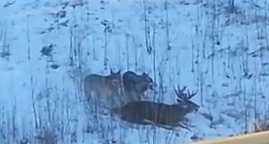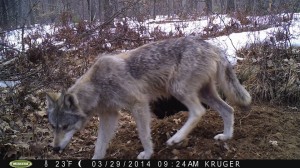
By now, you’ve probably heard about how U.S. District Judge Beryl Howell ruled that the removal of the wolf from the endangered list was “arbitrary and capricious” and violated the federal Endangered Species Act. And, with a stroke of a pen, returned the wolf to the endangered list and ended hunting and trapping seasons on them in Minnesota, Wisconsin and Michigan.
The U.S. Fish and Wildlife Service dropped federal protections from those wolves in 2012 and handed over management to the states.
Effective immediately, wolves in these states can only be killed in defense of human life.
Wolves now revert to the federal protection status they had prior to being removed from the endangered species list in the Great Lakes region in January 2012. That means wolves now are federally classified as threatened.
Outdoorsmen and women everywhere need to stand up and say “enough’s enough.” The Feds, once again, have gone back on a promise to conservationists in America, thanks to one liberal judge. I’m not the only one who’s saying this, but it’s flat-out wrong.

First, the facts:
Current estimates put wolf populations at the following numbers (as of 2014):
Minnesota: 2,400+ wolves.
Wisconsin: 660 wolves.
Michigan’s Upper Peninsula: 636 wolves.
Ontario: 8,000 to 10,000 wolves.
Updated numbers (1/28/22):
Minnesota: 2,500
Wisconsin: 1,250
Michigan’s U.P.: 700
Montana: 1,000
Idaho: 1,550
Wyoming: 350
Oregon: 175
Ontario: 10,00+
There are more than 80,000 wolves in North America, and more than 20,000 in the U.S. Wolves are not endangered. Not even close.
What everyone forgets here is that the original plan was to allow a sustained population of 250 wolves in Wisconsin a population that would be “socially acceptable.” This was changed after a federal judge allowed the management process to be stalled in the courts. Then, in 1999, when formulating a wolf recovery plan, Wisconsin arbitrarily set a goal of 350 to qualify the wolf as “recovered.”
In any event, we had a deal with the Feds at that point. When the population exceeded that number, we needed to come in and allow hunters and trappers manage the resource ‹ much like we manage the deer herd.
Well, the Feds turned their backs on the deal — anti-hunters and liberal lawmakers got further involved and the wolf population exploded. By 2012, Wisconsin had well in excess of 800 wolves (some research biologists I know put the estimate closer to 1,000+). Three times too many that would be socially acceptable. So, the hunt/trapping season was finally allowed. And, year by year, it has worked.
Going into this fall’s hunt/trap season Wisconsin had about 650 wolves, but that is still nearly two times the number of wolves that we agreed upon. Now, lately, a survey has surfaced indicating that a majority of residents (59%) do not want to see the wolf population reduced any further. This, in my opinion, was a flawed survey and flawed thinking.
The thinking, however, is one that should be easily quieted by simply pointing to our other main wildlife resource: whitetails.
But I digress. How many wolves could Wisconsin, for example, support from a habitat perspective? Probably 1,000 to 1,200. That¹s absolute maximum carrying capacity. This is where the situation mirrors what is happening with our white-tailed deer herd.
The best habitat in the state can support about 35 deer per square mile before significant harm is caused to the ecosystem. Unfortunately, landowners and managers allowed deer herds of much higher densities to exist for many years in the 1990s and early 2000s. Here in our area, we had some pockets with deer densities of 100 deer per square mile. Just like the wolves … that’s 3X too many. What happened?
Well, our forests have been significantly altered to the point where almost all of the understory is comprised of invasive species (buckthorn, sumac, bush honeysuckle, Japanese barberry). That was not sound wildlife management, but it wasn¹t the DNR¹s fault — they took drastic measures (because they were mandated by state law to do so) to bring the herd down to goals.
The plan (along with two consecutive harsh winters) worked in getting the herd down to goal or under goal throughout most of the state. At one point in the 2000s, we were experienced 40,000 + car-deer accidents here in Wisconsin. Ask any landowner, and they¹ll tell you that white pine, oak, cedar and myriad other trees and plant species are all but lost causes for regeneration sans an 8-foot high fence around a property.
The larger point here is this:
We need wolves. Aldo Leopold taught us that. No one is questioning it. Yes, wolves have a place on the landscape, but they need to be managed with as much care (actually more) than any other wildlife species we have because of their standing as the apex predator on the landscape.
States have wildlife departments for good reason. Let our trained wildlife managers do their jobs. One federal judge’s distorted opinion should not dictate wildlife management for the masses.

I fail to see how conservationists have been slighted in respect to this issue. We cannot depend solely on trained wildlife managers to make decisions that effect all species of wildlife. So many of those in charge of wildlife management are influenced, even controlled, by the hunting industry leaders who’s interests are in jeopardy when game populations drop to what are natural levels. Whether the reduction comes from natural predation, hunting/trapping, habitat loss, or disease. Wildlife managers are in a position to skew data to support what the hunting industry views as desirable to sustain their market. With the departments of wildlife management in most states so closely connected to those who’s livelihood depends on a thriving hunting and fishing public, it results in a conflict of interest when making decisions on how to manage natural resources. Just as it does when logging and mining are influencing decisions on protecting the environment (otherwise known as fish/wildlife habitat) from being exploited. I believe that we all would benefit more from having decisions in these areas of natural resources management being made with input from a more diverse representation of all who have the right to enjoy the outdoors. I have commented on different subjects discussed through your website in the past. I have been an outdoorsman (hunter/fisherman) for over 40yr. and I enjoy times of abundant game that allow us more opportunities to enjoy being in the natural world, doing what I believe is natural for people to do in the outdoors… hunt and fish. But the fear mongering and attempts to demonize the predator species just to get one more animal on the \kill-list\ offends me, and those who practice this do not represent me or those whom I choose to associate with as an outdoorsman. The videos of wolves, coyotes, and other major predators, fulfilling what is their natural reason for existing, does not offend me, but I see it used to stir-up the ire of the hunting public in order to manipulate opinions. This same manipulation is what I fear is influencing the wildlife managers in many states. As I have stated before, I will gladly defer to the predator species as primary control agent of prey species if game levels drop below what is determined to be huntable populations. As things find their natural balance between predator and prey, I am certain that there will be enough room for those of us who still enjoy real hunting, but maybe not enough for anyone to get wealthy from. Don’t be offended by the reactions of those folks who have put themselves in the \anti-hunting\ category when they complain about hunting based on what they see in hunting videos and then turn-around and use a video to goad hunters/outdoorsmen into supporting your opposition to an entirely different activity… and a natural one at that. Thank you and your publication for providing a chance for all of us to discuss an important matter, but I as a reader and viewer would feel better served by a more neutral (fair) tone when issues like these are presented.
It would be such a shame if the wolves got hold of some of these bunny huggers !
I live in Virginia and we don’t have any wolves in our state. I had seen the video of the wolves going after the white tail buck, had I been there in person, I am sure that I would have become a law breaking citizen because I would have shot them. I agree with Mr Schmidt that it should be up to wildlife managers as to wolf numbers and how to deal with keeping them in control.